History of Indians’ participation in the South African Military
The South African Indian Legion (SAIL) of Military Veterans, have encapsulated the roles and success of Indians in the military spanning from the Anglo-Zulu War to present, which is currently part of a new exhibition at the Ditsong National Museum of Military History in Saxonwold, Johannesburg. The non-profit organisation researches, documents, and creates awareness surrounding the South African Indian military history.

Military pilot officer, Dharamraj Aheer Goordeen.
Image: Supplied
The South African Indian Legion (SAIL) of Military Veterans, have encapsulated the roles and success of Indians in the military spanning from the Anglo-Zulu War to present, which is currently part of a new exhibition at the Ditsong National Museum of Military History in Saxonwold, Johannesburg. The non-profit organisation researches, documents, and creates awareness surrounding the South African Indian military history.
The South African War
Anglo-Zulu War (1879)
The first recorded military involvement of Indians in South Africa was during the Anglo-Zulu war of 1879. Indian soldiers, drawn from the Indian Army, played a supporting role, primarily serving as sentries to safeguard garrisons and storage facilities in Natal. The British initially deployed a small contingency of 22 Indian men, which grew in size as the war progressed. This early involvement marked the beginning of Indian participation in the military in South Africa.

The history of Indians in the South African Military can be viewed at the Ditsong National Museum of Military History in Johannesburg.
Image: Supplied
ANGLO-BOER WAR (1899 - 1902)
During the Anglo-Boer War, Indians made significant contributions through various roles. An Indian Army Contingent was deployed, accompanied by camp followers and the Indian Stretcher Bearer Corps, which provided crucial medical support. Indian traders also offered financial backing to the war effort.
Indian Contingent in the War
The British deployed a contingent from the Indian Army as auxiliary forces, primarily stationed at garrisons and remount camps across the country. Although their role was largely supportive, Indian soldiers occasionally found themselves in direct combat situations with Boer forces. The Indian contingent consisted of over 7 000 non-combatants providing essential support throughout the conflict. Their contributions played a vital part in the war effort. The Indian contingent comprised 3 Cavalry Regiments, 4 Infantry Battalions, 3 Field Batteries, Ammunition Column and 1 Field Hospital.
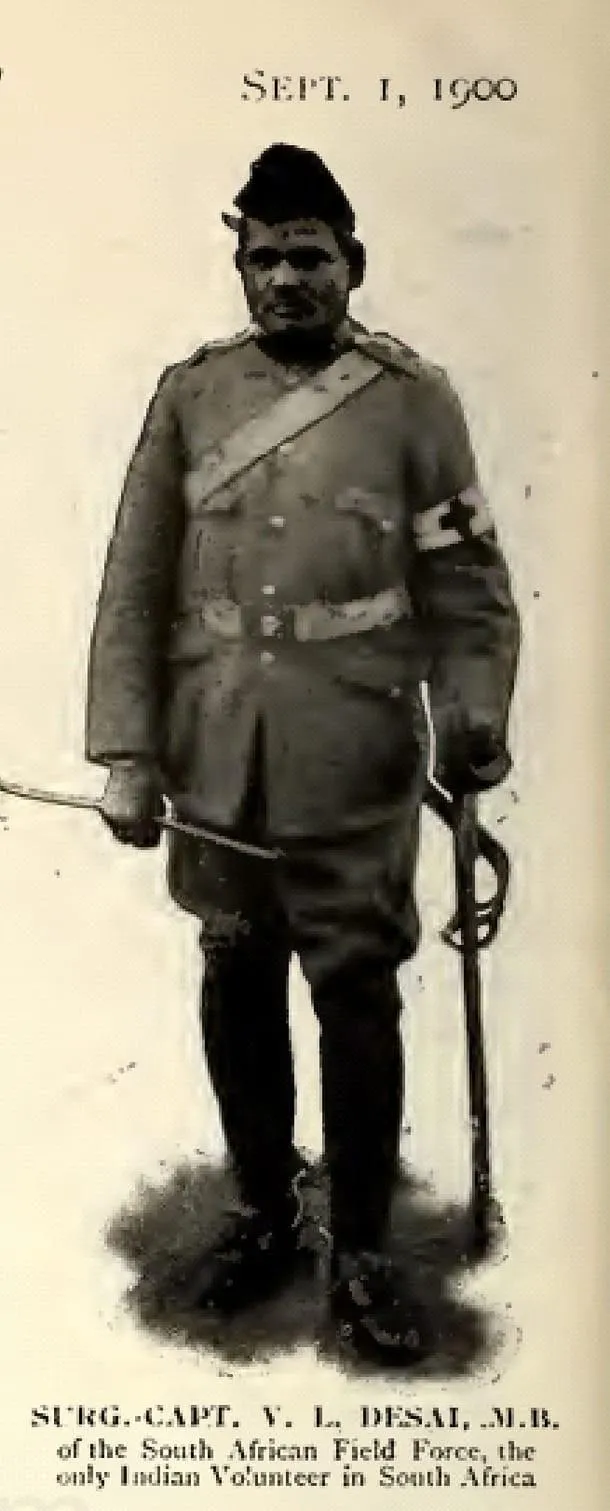
Surgeon Captain Umedram Lalbhai Desai, who was an orthopedic surgeon.
Image: Supplied
Gallantry in the Battle of Sanna’s Post
During the battle of Sanna’s Post on March 30, 1900, Sowar Dost Muhammed Khan, No, 1706 of 18th Bengal Lancers, demonstrated exceptional bravery. Khan, an orderly to Lieutenant Francis Maxwell, refused to retreat despite being under heavy fire and risking capture.
When a fellow soldier’s horse was shot, Lieutenant Maxwell rushed to assist, with Khan by his side. Despite Lieutenant Maxwell’s orders to retreat, Khan held the lieutenant’s horse steady, allowing the dismounted soldier to mount safely and escape. Khan was wounded in the process.
Khan’s gallantry earned him the 3rd Class Order of Merit, conferred by the Governor General on September 27, 1901. Lieutenant Maxwell, who was decorated with the Victoria Cross for his actions, cited Khan’s bravery. Khan was wounded again at Diamond Hill.
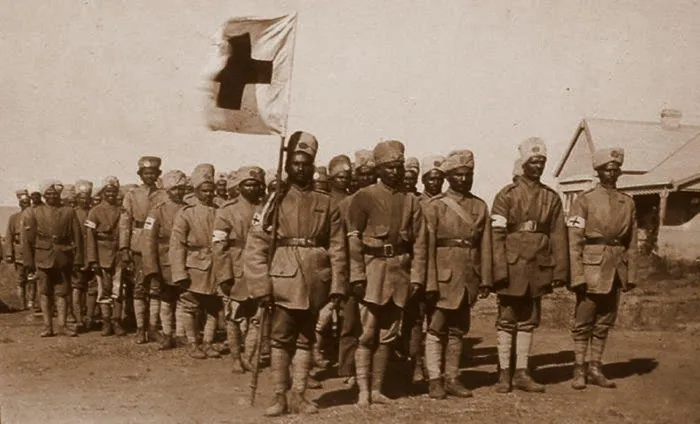
Indian Bearers in Dundee during the Anglo-Boer War.
Image: Supplied
The Indian Bearer Corps
During the second Anglo-Boer War, the Natal Indian Congress mobilised volunteers to form the Indian Bearer Corps, comprising 34 leaders and 1 100 men. This field unit served at Colenso, Spion Kop, and Vaalkrantz, providing medical support to wounded soldiers.
Indian leaders raised the corps to demonstrate loyalty to the British crown, despite sympathising with the Boer cause. The unit was funded by Indian traders, who provided uniforms and equipment.
The Indian Bearer Corps consisted of stretcher-bearers trained in basic medical care. Their duties included providing immediate medical assistance on the battlefield and transporting wounded British soldiers to nearby hospitals using dhoolies, despite the challenging African terrain. The unit’s outstanding performance surprised British authorities.

Indian Stretchers Bearers carry a wounded soldier in a dhoolie.
Image: Supplied
The Orthopedic Surgeon
Surgeon Captain Umedram Lalbhai Desai, M.B, an orthopedic surgeon of Indian descent, served as a volunteer in South Africa during the Anglo-Boer War. He held a triple diploma from Edinburgh and Glasgow; and was part of the South African Field Force.
As part of celebrations marking the occupation of Pretoria by British forces, Dr Desai addressed a gathering of Indians at Seth Mahomed Surti’s residence in Queenstown. In his victory speech, he highlighted the British Empire’s success and noted that the Queen had learned the Hindustani language and granted honors to Indians on par with the British.
He was later permitted to resign his temporary commission from the Indian Medical Service, effective April 8, 1919, subject to His Majesty’s approval.
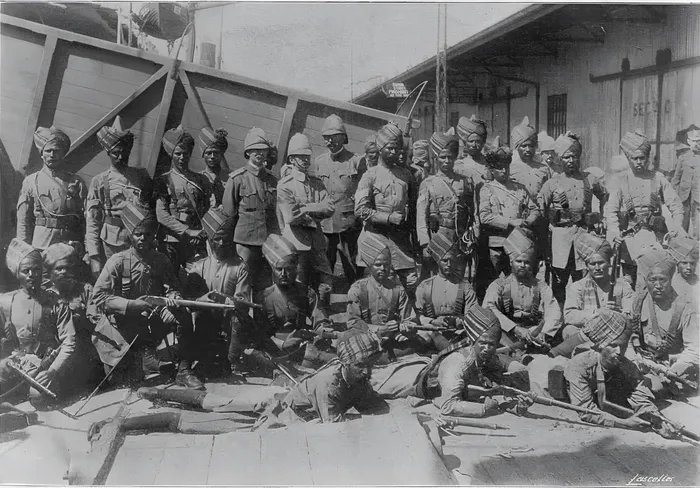
The 3rd Madras Lancers Cape Town Docks
Image: Supplied
THE GREAT WARS
World War 1 (1914 - 1918)
Indian Ambulance Corps
During World War 1, Indians in South Africa sought to prove their loyalty to the British Crown by volunteering for military service. The Indian Bearer Corps was re-established and later renamed the Indian Ambulance Corps. By the war’s end, 660 men had served in East Africa with either the 1st or 2nd Company. The Corps comprised ex-indentured labourers, colonial-born Indians, and some veterans of the Madras infantry regiments. The Indian community supported the soldiers by providing uniforms, rations, and other essentials.
Indian Distinguished Service Medal
Lalbadhur Jungbadhur Singh, a Bearer with the 1st Indian Bearer Company, demonstrated exceptional bravery. He was awarded the Indian Distinguished Service Medal for his gallantry in the field. In August 1916, during a Kedati in East German Africa, Singh was shot three times with a machine gun.
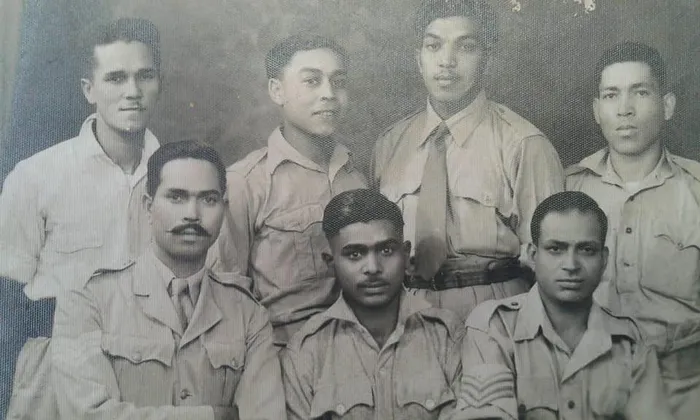
Indian Malay Corps during World War 2.
Image: Supplied
World War 2 (1939 - 1945)
Indian Malay Corps
In 1940, Parliament approved the inclusion of Indian, Coloured, and Black volunteers in the Union Defence Force, leading to the establishment of a separate military corps. The Indian Service Corps was formed on June 26, 1940, under Colonel GA Morris.
Due to low volunteer numbers, the Indian Service Corps was renamed the Indian Malay Corps on December 19, 1940, to include members of the Cape Malay community, Eventually, the unit merged with the South African Cape Corps before the end of the war.
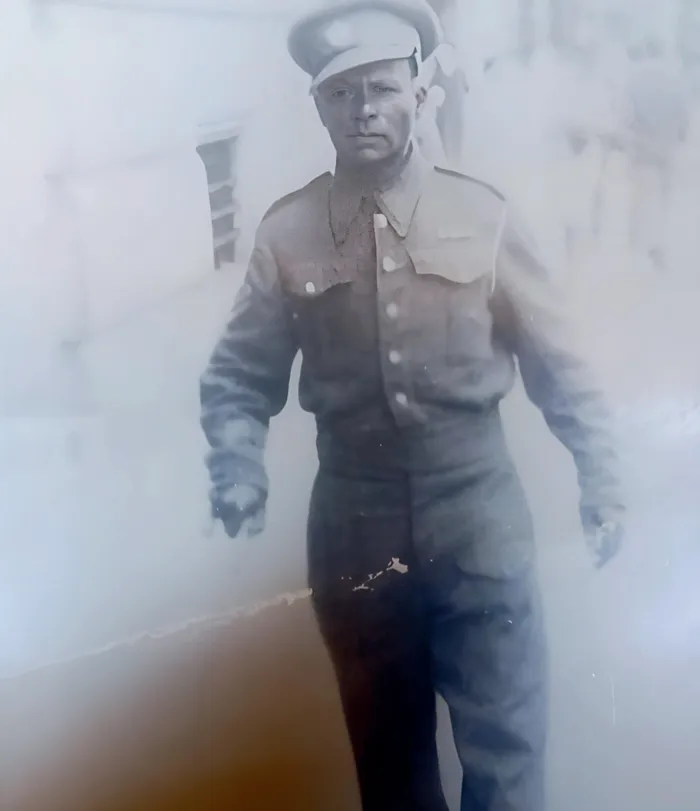
Private George Moodley, who was part of the Indian Malay Corps.
Image: Supplied
The Augustine Brothers
Two brothers, Private Frank Augustine and Private Donald Wilfred Augustine, made the ultimate sacrifice in different wars. Frank, aged 19, died on August 5, 1917, serving with the Indian Bearer Corps in World War 1, and was buried at Dar Es Salaam War Cemetery in Tanzania.
Donald, Frank’s younger brother, lost his life on December 11, 1940, at the age of 25, while serving with the Indian Malay Corps in World War 2. He was buried in Nairobi, Kenya.
Prisoner of War
Private George Moodley joined the Union Defence Force on May 14, 1941, as part of the Indian Malay Corps during World War 2. He served with the 20th Division Field Park Coy in the South African Engineer Corps, working as a steward and general labourer. His capture as a prisoner of war was confirmed on November 12, 1942, and he was allocated prisoner of war number 18745.
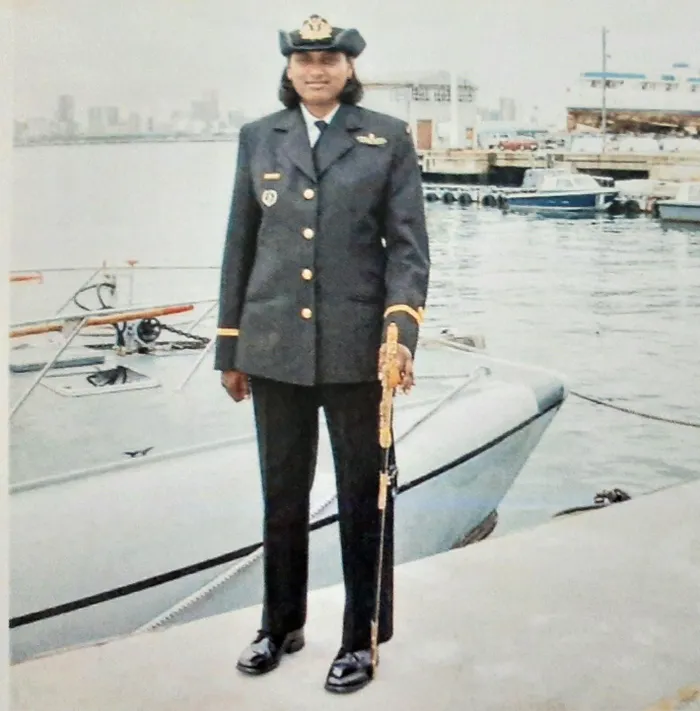
Sub-Lieutenant Latha Starling made history as the first female Commander at sea.
Image: Supplied
On June 20, 1942, during the recapture of the Part City of Tobruk in Libya by Axis Forces, Moodley was among the labourers offloading a ship when an aircraft bomb subsequently exploded in front of him during the air raid. Moodley sustained injuries by fracturing his right leg, injuring his kneecap and his left ankle, as well as his right hand and left shoulder. He also further suffered shrapnel to his scalp.
According to Moodley’s war records, he served as a prisoner of war in Libya, Italy, France and Germany. On April 9, 1944, Moodley returned to the Union of South Africa’s military strength and was discharged from military service on March 23, 1947, with his last unit being the South African Cape Corps.
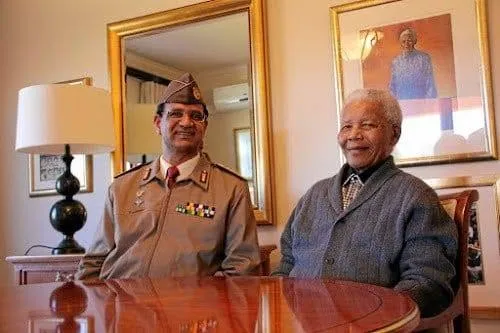
Lieutenant-General (Dr) Vejaynand Indurjith Ramlakan with Nelson Mandela.
Image: Supplied
The Pilot Officer
Born on September 10, 1917, in South Africa, Pilot Officer Dharamraj Aheer Goordeen left for India to study medicine. However, with the outbreak of World War 2, he volunteered for the Royal Indian Air Force, becoming the first known South African of Indian origin to become a military pilot.
Goordeen flew the Westland Lysander II, with 4 Squadron in Kohat, India. Tragically, on April 21, 1942, his aircraft crashed soon after takeoff, and Goordeen, just 24 years old, succumbed to his injuries.
Goordeen’s father, Aheer, was a farmer and businessman who during the Anglo-Boer War, was the only Indian businessman authorised to trade horses with the military. His father also played a pivotal role in politics and worked in the resistance movement. He was noted for his social work and acts of charity within the community.
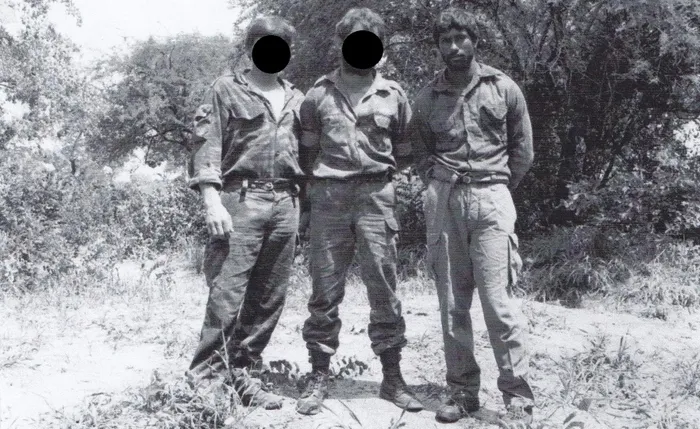
Special Forces Operator Warrant Officer Class 2 Laren Krishna in Angola.
Image: Supplied
The Gunner
Sergeant Muhammad Ali Khan Darling, service number 10235, served as a navigator/gunner in the Royal Indian Air Force, flying on the Vengeance AN799 aircraft with 7 Squadron.
Tragically, Darling, just 21 years old, and his pilot, Flying Officer Ajit Singh, were killed in an aircraft accident on February 19, 1944, while enroute to Gwalior/Lahore. The aircraft crashed near Hariki Road.
Darling was commemorated at the 1939-1945 War Memorial in Delhi and Karachi, honouring his sacrifice. He was the son of Faiz M. Khan and Katiya Bibi of Durban.

Captain Koomaresen “Vino” Eargambram.
Image: Supplied
THE SOUTH AFRICAN MILITARY - POST WORLD WARS
SA SPECIAL FORCES
The Indian Recce
Laren Krishna joined the South African Navy in January 1984 as part of the 2-year voluntary national serviceman programme for Indians, undergoing basic training at SAS Jalsena.
Krishna embarked on the Special Forces cycle in 1985 and qualified as the first South African Special Forces Operation of Indian origin April 16, 1987. He then joined 1 Reconnaissance Regiment in Durban.
At just 20 years old, Krishna became operationally active in Angola, participating in notable operations like Operation Modular and other covert missions across the border during the South African Border War.
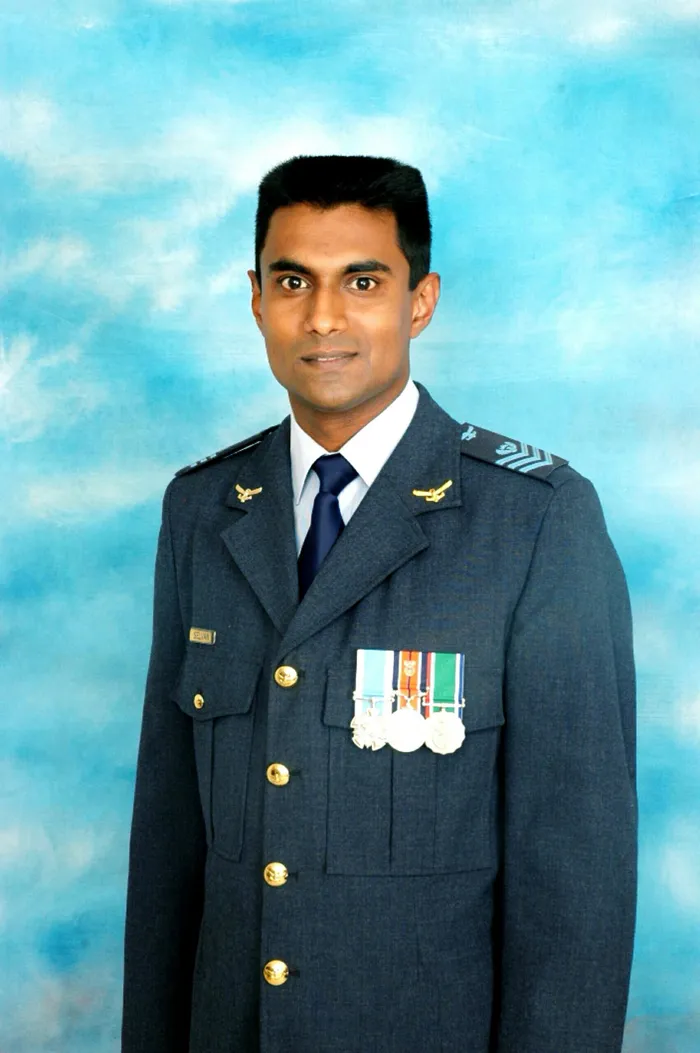
Flight Sergeant Vasudevan “Vinesh” Selvan.
Image: Supplied
SA ARMY
The Commandos
On December 13, 1984, twenty members of the Indian Commando Unit, Durban North Commandos, were deployed to South West Africa. On arrival, they received additional 2 weeks of orientation and bush warfare training in Sector 10.
The group was attached to the 10 Armoured Car Squadron in Oshakati, performing duties as a support group to the squadron, including foot and vehicle patrols, escorts and ambushes. 2nd Lieutenant Vikram Singh made history as the first South African of Indian origin to be commissioned as an officer in the Commandos.
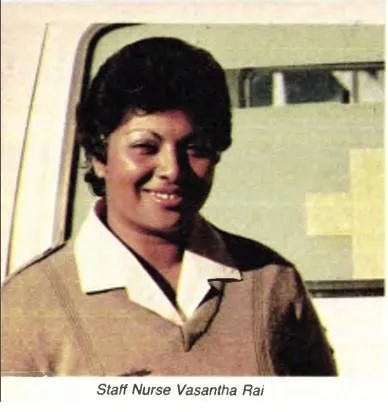
Staff nurse Vasantha Rai.
Image: Supplied
The General
Indrani Arends joined the Defence Force in 1988 as part of the second batch of Indian females recruited by the SA Navy, training at SAS Jalsena in Durban. She broke barriers in 1991 by becoming the first Indian female to enlist in the South African Army.
Arend’s achievements continued to excel as she was the first Indian officer, the first non-European, and female to win the Leadership Trophy on the officer’s formation course in 1992. In 2016, Arend was promoted to brigadier general, becoming the first Indian General in the SA Army.

Coin Training M57/88 - Maleoskop - Group 1.
Image: Supplied
SA NAVY
SAS Jalsena
Following World War 2, General Jan Smuts declared that Indians weren’t needed in the South African military. However, after persistent efforts by Indian leaders to achieve equality, the government reversed this decision in 1974, allowing Indians to serve.
The first group of Indian volunteers joined the Navy on January 15, 1975, forming the South African Indian Corps Training Battalion (SAICTB). In 1979, this unit was renamed the SAS Jalsena, marking a significant milestone in integration.
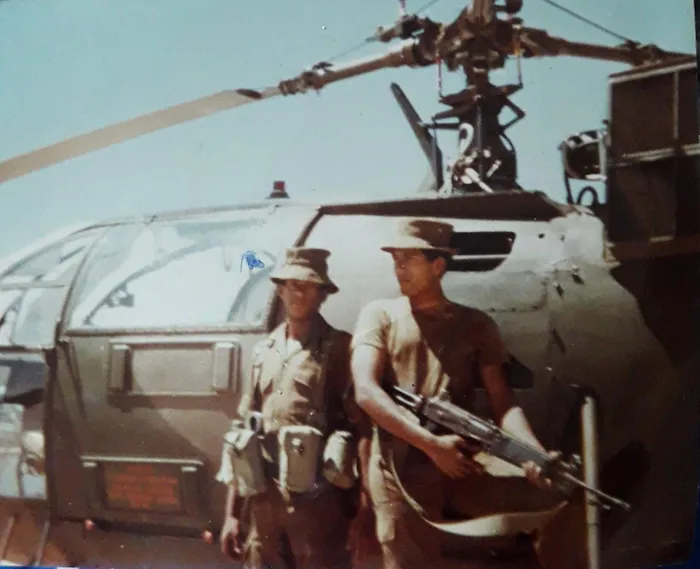
Marine Kevin Pillay and Marine Raees Vawda.
Image: Supplied
The Swans
Women first in the South African Navy during World War 2 in civilian roles. A significant milestone was reached on January 8, 1973, when women were enlisted in uniform for non-combat duties.
A notable step towards diversity was taken on January 12, 1987, when five Indian women joined the Navy, participating in the first multi-racial basic training course at SAS Simonsberg in Cape Town, later completing their training at SAS Jalsena.
The Strike Craft Commander
Commander Yegan Moodley was the first South African of Indian origin to complete a Bachelor of Military Science degree. He was appointed as a commander of the South African strike craft, SAS Jan Smuts, at a parade on Salisbury Island in Durban on December 14, 1994.
The First Female Commander at Sea
Sub-Lieutenant Latha Starling made history on May 20, 2005, as the first female Commander at sea. She took the helm of SAS Tekwane, an inshore patrol vessel, at the Durban Naval Base.

Commander Yegan Moodley.
Image: Supplied
SA MARINES
The Marines
The South African Marines was formed in 1979 to safeguard harbours and national key points, leveraging both aquatic and land capabilities. The foundation of this unit began in September 1978, when 80 Indian soldiers, having completed basic training at SAS Jalsena in Durban, were transferred to Simon’s Town, Cape Town for further military training.
SA AIR FORCE
Breaking Barriers in Aviation
Until the mid-1980s, the South African Air Force(SAAF) pupil pilot training program was restricted to White males. This policy shifted in 1986, allowing Indians and Coloureds to apply.
Captain Koomaresen “Vino” Eargambram, from Cliffdale near Hammarsdale in KwaZulu-Natal, became the first non-European to undergo flying training. After abandoning his computer science studies at the University of Natal, Eargambram enlisted in the SAAF and began his flying journey with Pupil Pilot’s Course 1/89 in 1988.
Eargambram excelled in his training, being selected as the best student during his basic military training at the Air Force Gymnasium.He received his wings on July 5, 1990, and went on to qualify as a helicopter pilot, flying Pumas with 15 Squadron at Air Force Base Durban.
Pioneering the Skies
In January 1997, Lieutenant Kerina Moodley became the first non-European female pilot recruited by the South African Air Force (SAAF), making her one of only 10 female pilots in the SAAF at the time. Moodley also made history as the first South African female of
Indian origin to be commissioned as an SAAF officer, paving the way for future generations.
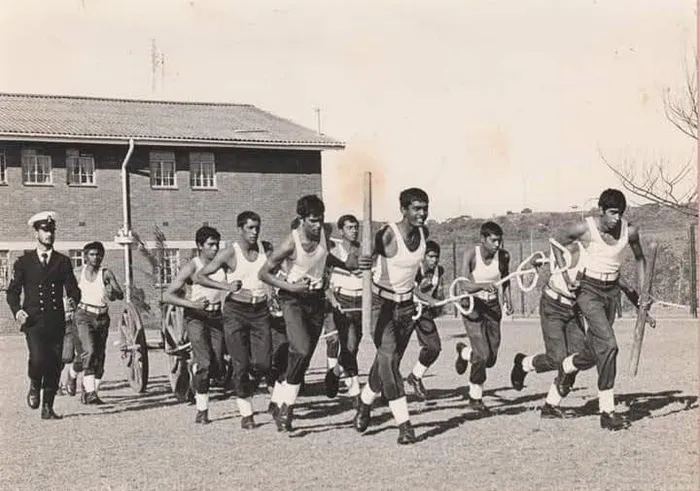
SAS Jalsena cannon run
Image: Supplied
Bravery in Burundi
Flight Sergeant Vasudevan “Vinesh” Selvan was the first recipient of the Nkwe Decoration series in 2004, which replaced the Honoris Crux series for bravery. Flight Sergeant Selvan was deployed in Bujumbura, Burundi, on Operation FIBRE in February 2002. Selvan was stationed at the South African National Defence Force base camp supporting combat search and rescue operations.
At 23:00 on February 20, 2002, he displayed exceptional courage whilst in grave danger. There was an attempt to murder a Special Forces Commander. The officer was unarmed, and after an unsuccessful attempt to disarm his attacker, fled towards the camp of the SAAF personnel with his assailant in hot pursuit. Selvan closed in on the officer and positioned himself in the line of fire to fend off the attacker.
Selvan deliberately took a firing position; this courageous and daring action allowed the badly wounded officer to escape. Selvan remained in his firing position, even though he was exposed due to the non-availability of cover. After drawing effective fire from the attacker and being wounded in both legs, Selvan returned fire and effectively neutralised the attacker, thus saving the life of the seriously wounded officer. Selvan was awarded the Nkwe Ya Selefera “Silver Leopard” Decoration for bravery (Medal No. 001).
SA MILITARY HEALTH SERVICES
Activism to Leadership
Lieutenant General Vejaynand Indurjith Ramlakan joined Umkhonto we Sizwe (MK) in 1977 as an underground operative while studying medicine at the University of Natal. He underwent military training in South Africa and Swaziland.
Ramlakan qualified as a medical doctor in the 1980s and became a military commander of an MK unit. During this time, he was involved in bombing operations in the Durban area.
Ramlakan was convicted of bombing the house of a politician and served 12 years on Robben Island. After his release, he integrated into the South African National Defence Force (SANDF) in 1994. Ramlakan later rose to prominence, becoming the Surgeon General of the South African Military Health Service.
A Life of Activism and Service
Devenathan “Dave” Perumal, from Durban, joined the Natal Indian Youth Congress at 17 and was later recruited into uMkhonto weSizwe (MK), the military wing of the African National Congress. Perumal’s involvement in the fight against apartheid began at a young age.
Perumal received training in Russia and participated in active military operations against the apartheid government. One of his notable actions was the destruction of the Victoria Street Bridge on March 21, 1962, which he carried out with his unit.
Forced into exile, Perumal went to London, where he pursued a career in medicine. Following South Africa’s transition to democracy, Perumal integrated into the South African National Defence Force, bringing his skills and experience to the new era.
Breaking Barriers in Military Nursing
Staff Nurse Vasantha Rai trained at the RK Khan Hospital in Chatsworth, Durban. In 1979, she began her career with the South African Defence Force as a civilian nurse.
Rai later transitioned into uniformed service, making history as the first Indian female to enlist in the South African Medical Service as a military practitioner. Her achievement paved the way for future generations of women in the military.
* The South African Indian Legion (SAIL) of Military Veterans will host a lecture on “The Role of Indians in the South African Military” at the Ditsong National Museum of Military History in Saxonwold, Johannesburg, on May 25, from 12.30pm to 2pm. The lecture will encompass an overview of the Indian participation in the military over the last 120 years. For more information, or if you would like to document your family’s military history call 084 450 4892.
Related Topics: